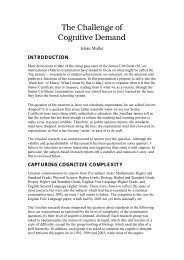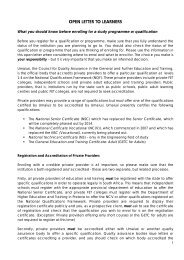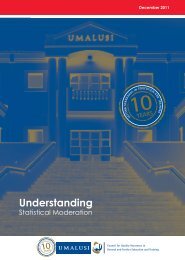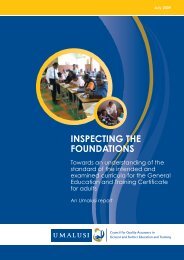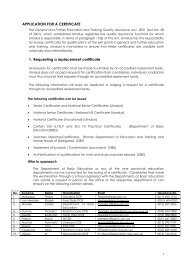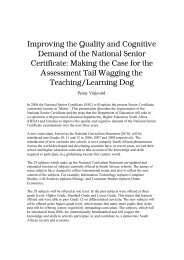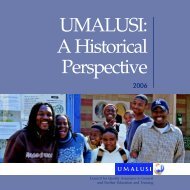Umalusi AET Report
Umalusi AET Report
Umalusi AET Report
- No tags were found...
Create successful ePaper yourself
Turn your PDF publications into a flip-book with our unique Google optimized e-Paper software.
interacting with staff and learners.Negative observations from evaluators included observing completely exposed electrical wiringin welding classes; broken fl oor boards, which meant learners were in danger of falling severalfeet onto the ground below; and sewing machines left lying around for people to trip over. Onecomment from a provider was that “nothing ever happened in rural areas” so the provider didnot need to bother with the safety and security of learners. Another felt that it could be added tothe job description of the “trainer”. It seems that health and safety issues had “fallen through thegap” in the integration of education and training or in cost-cutting exercises, as they seemed to beespecially bad in skills training sites.However, there were a few examples of good practice. These included sending groups of learnerson First-aid training, appointing an emergency management team, condom dispensers on site,making use of a participant who is also a police reservist. One of the most notable was a healthand safety checklist given to facilitators to complete at every new venue at which they facilitate.When problems are encountered by facilitators, these are then brought to the attention of theclient, company or building owner by the <strong>AET</strong> provider.LEARNER ACCESS AND SUPPORTThe profi le data on learner access and support, submitted by provider sites, appeared to bequite impressive. Yet compliance on this criterion was weak. Of the 50 sites evaluated, 62% scoredless than 3 and did not comply with requirements of this criterion. Achievement on the differentindicators was variable: only 52% showed adequate evidence (score of 3) of an admission policy;47% could provide evidence of an outline of a learner support programme; only 46% continuallymonitor and review learner disciplinary polices, and 32% use learner feedback to review or planlearner support. Career counselling and guidance fared slightly better and it was found that 62% ofsites continually monitor and review career counselling and guidance.As with other areas of low compliance, <strong>AET</strong> providers regard learner access and support as beingoutside of their ambit of responsibility. It was generally viewed as that of the client, especially theHuman Resources (HR) department or trade union shop stewards. Other providers stated that therewere few “discipline problems” with adults so the intervention was not necessary. Learner selectionwas almost always done by the client and placement adequately dealt with by placementtesting. It was suggested that should any problems arise a “security guard could be called”. Moredeveloped and sophisticated notions of support and nurturing learning were generally not in place,though some providers made use of learner codes of conduct or learning contracts. At one site,learners had specifi c permission to telephone the “head” if they had any problems; and at anotherfull and appropriate use was made of SMS messages to remind learners of classes or importantinformation.CLIENT SATISFACTIONThe criterion “Client satisfaction” created a middle point among providers: 50% of sites were foundto be compliant (score of 3) in terms of an overall score on this criterion. Providers seemed to havean awareness of client and learner satisfaction, but only 48% could provide adequate evidence ofa report or minutes of meetings with clients or learners. In general providers were more interestedin the satisfaction of corporate clients than learners. There were a few examples of good and badpractice. Some providers were found to have conducted learner surveys after every course orprogramme; changed textbooks that learners had found diffi cult; and upgraded library stock andintroduced daily newspapers because learners wanted to read more. One evaluator uncoveredan extremely bad example of compromising learner interests for a client. Learners on a companytraining programme had to wake up at 4am and return home at 9pm to travel to a town far away,because the training contract had been given to a provider (friend) in that town even thoughthere were facilities close to their workplace.27



